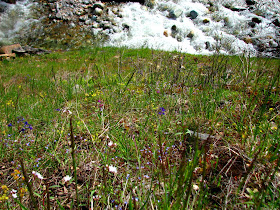Blue-eyed Mary
Collinsia parviflora
Scrophulariaceae (Figwort Family)
The hard part isn't being able to identify Collinsia, but being able to spot it in the first place. The flowers are tiny, rarely more than a few millimeters across. Luckily they're often found growing in groups, on relatively bare ground. Look for little snapdragony-type flowers growing on red, hairy stems with narrow linear leaves. The entire plant is just a wisp, really, and a mass of them blanketing the ground is an enchanting springtime delight.
Delightful though they may be, they are also notoriously hard to photograph. Here, Blue-eyed Marys dot the ground along with Larkspur, Shooting Star, Biscuitroot and Woodland Star. Kootenai Creek tumbles below the hillside.
Range:
 You'll find Collinsia in moist, shady forests, often growing where other plants are sparse. Its large range extends throughout the southern parts of Canada, south to Texas and east to Colorado. In Montana, it's mostly found in the southern and western parts of the state.
You'll find Collinsia in moist, shady forests, often growing where other plants are sparse. Its large range extends throughout the southern parts of Canada, south to Texas and east to Colorado. In Montana, it's mostly found in the southern and western parts of the state.What's in a Name?
Who is this Mary lady? There have been a few rather famous Marys throughout history (it was the #1 most common name in 1900, and still remained there as of 1990), so I guess the mystery isn't quite as intriguing as if the plant was called...say, Blue-eyed Leah, but still. It seems the origin of this particular moniker is lost to us; I certainly can't find any mention of it.
Scientific names are much easier to track down. Collinsia is named in honor of Zaccheus Collins, VP of the Philadelphia Academy of Natural Sciences around the turn of the 19th century. Thomas Nuttall named the genus after him, and David Douglas named the species in 1827. The Latin word parvus means small-in this case, small flowers (parviflora). There are 19 species of Collinsia, including one with "giant" flowers, aptly named C. grandiflora.
 Members of the Scrophulariaceae family (or "Scrophs", as we plant geeks like to call them) are named for scrofula, which they're supposed to cure. Scrofula is an archaic word for certain forms of tuberculosis, some of which are spread through unpasteurized milk (the Latin scrofule means "brood cow"). To further yuck it up, Scrophs have also been used to treat hemorrhoids, which in the olden days were known as "figs" (hence the common name "figwort family"--wort generally meaning "a plant"). Hemorrhoid plants. Yikes!
Members of the Scrophulariaceae family (or "Scrophs", as we plant geeks like to call them) are named for scrofula, which they're supposed to cure. Scrofula is an archaic word for certain forms of tuberculosis, some of which are spread through unpasteurized milk (the Latin scrofule means "brood cow"). To further yuck it up, Scrophs have also been used to treat hemorrhoids, which in the olden days were known as "figs" (hence the common name "figwort family"--wort generally meaning "a plant"). Hemorrhoid plants. Yikes! Tidbits: Other Scrophs include penstemon, snapdragons, paintbrush, foxglove and monkeyflower. All have characteristic corollas (petal arrangements) with upper and lower "lips". In Collinsia, the upper lip is usually lighter than the dark blue lower lip.
There are brief mentions of Blue-eyed Mary being used by the Kayenta Navajo as a "plant to make horses run fast", and Ute tribes used it externally on sore flesh.
Collinsia is one of those sought-after plants that enjoys shade and can tolerate shallow soil. It also has a long bloom season (Apr-July) and will establish and spread easily if there's not too much competition from surrounding plants.
This is an annual plant; it grows from seed produced the previous season rather than surviving by underground storage structures. You can start collecting seeds (a somewhat tedious endeavor) in late May, and sow them outdoors in the fall.
This is a great example of how wild gardening conveniently mimics natural systems. Plants drop their seeds in the fall, and wait for spring moisture and temps to be right for germination. You can do the same thing. It takes the guesswork out of the equation, and the plants will thank you for it. Come spring, you can sit back and enjoy the show.
This is a great example of how wild gardening conveniently mimics natural systems. Plants drop their seeds in the fall, and wait for spring moisture and temps to be right for germination. You can do the same thing. It takes the guesswork out of the equation, and the plants will thank you for it. Come spring, you can sit back and enjoy the show.
Spotlight On... features Montana native plants that are currently on display in our natural areas. Have a plant that you'd like to see featured? Let us know!




.JPG)



















